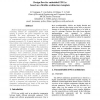Free Online Productivity Tools
i2Speak
i2Symbol
i2OCR
iTex2Img
iWeb2Print
iWeb2Shot
i2Type
iPdf2Split
iPdf2Merge
i2Bopomofo
i2Arabic
i2Style
i2Image
i2PDF
iLatex2Rtf
Sci2ools
DATE
2008
IEEE
2008
IEEE
Design flow for embedded FPGAs based on a flexible architecture template
Modern digital signal processing applications have an increasing demand for computational power while needing to preserve low power dissipation and high flexibility. For many applications, the growth of algorithmic complexity is already faster than the growth of computational power provided by discrete general purpose processors [1]. A typical approach to address this problem is the combination of a processor core with dedicated accelerators. Since changes in standards or algorithms can change the demands on the accelerators, an attractive alternative to highly customised VLSImacros is the use of reconfigurable embedded FPGAs (eFPGAs). First commercial products combining a general purpose processor core and an embedded FPGA recently emerged (e.g. Stretch S6000 [2], Menta eFPGAaugmented CPUs [3]). For many digital signal processing applications, a significantly improved efficiency in terms of power dissipation, throughput and chip area can be achieved by tailoring both the processor co...
DATE 2008 | Digital Signal Processing | Hardware | Processor Core | Signal Processing Applications |
Related Content
| Added | 29 May 2010 |
| Updated | 29 May 2010 |
| Type | Conference |
| Year | 2008 |
| Where | DATE |
| Authors | B. Neumann, Thorsten von Sydow, Holger Blume, Tobias G. Noll |
Comments (0)

